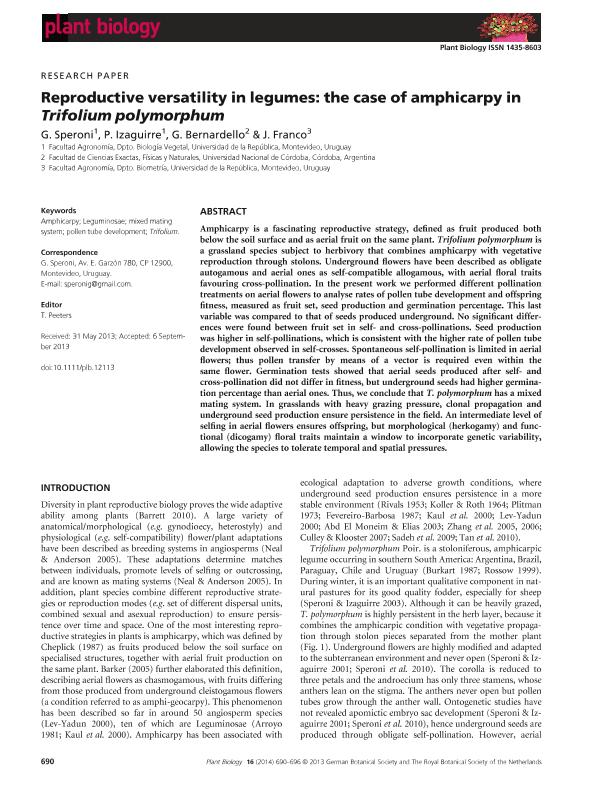Mostrar el registro sencillo del ítem
dc.contributor.author
Speroni, G.
dc.contributor.author
Izaguirre, P.
dc.contributor.author
Bernardello, Gabriel Luis Mario

dc.contributor.author
Franco, J.
dc.date.available
2017-03-06T13:47:36Z
dc.date.issued
2014-04
dc.identifier.citation
Speroni, G.; Izaguirre, P.; Bernardello, Gabriel Luis Mario; Franco, J. ; Reproductive versatility in Legumes: the case of amphicarpy in Trifolium polymorphum; Wiley Blackwell Publishing, Inc; Plant Biology; 16; 4-2014; 690-696
dc.identifier.issn
1435-8603
dc.identifier.issn
1438-8677
dc.identifier.uri
http://hdl.handle.net/11336/13539
dc.description.abstract
Amphicarpy is a fascinating reproductive strategy, defined as fruit produced both below the soil surface and as aerial fruit on the same plant.Trifolium polymorphumis a grassland species subject to herbivory that combines amphicarpy with vegetative reproduction through stolons. Underground flowers have been described as obligate autogamous and aerial ones as self-compatible allogamous, with aerial floral traits favouring cross-pollination. In the present work we performed different pollination treatments on aerial flowers to analyse rates of pollen tube development and offspring fitness, measured as fruit set, seed production and germination percentage. This last variable was compared to that of seeds produced underground. No significant differences were found between fruit set in self- and cross-pollinations. Seed production was higher in self-pollinations, which is consistent with the higher rate of pollen tube development observed in self-crosses. Spontaneous self-pollination is limited in aerial flowers; thus pollen transfer by means of a vector is required even within the same flower. Germination tests showed that aerial seeds produced after self- and cross-pollination did not differ in fitness, but underground seeds had higher germination percentage than aerial ones. Thus, we conclude thatT. polymorphumhas a mixed mating system. In grasslands with heavy grazing pressure, clonal propagation and underground seed production ensure persistence in the field. An intermediate level of selfing in aerial flowers ensures offspring, but morphological (herkogamy) and functional (dicogamy) floral traits maintain a window to incorporate genetic variability, allowing the species to tolerate temporal and spatial pressures
dc.format
application/pdf
dc.language.iso
eng
dc.publisher
Wiley Blackwell Publishing, Inc

dc.rights
info:eu-repo/semantics/openAccess
dc.rights.uri
https://creativecommons.org/licenses/by-nc-sa/2.5/ar/
dc.subject
Anficarpia
dc.subject
Biologia Reproductiva
dc.subject
Multiplicacion Vegetatica
dc.subject
Leguminosas
dc.subject.classification
Biología Reproductiva

dc.subject.classification
Ciencias Biológicas

dc.subject.classification
CIENCIAS NATURALES Y EXACTAS

dc.title
Reproductive versatility in Legumes: the case of amphicarpy in Trifolium polymorphum
dc.type
info:eu-repo/semantics/article
dc.type
info:ar-repo/semantics/artículo
dc.type
info:eu-repo/semantics/publishedVersion
dc.date.updated
2017-03-03T19:00:45Z
dc.journal.volume
16
dc.journal.pagination
690-696
dc.journal.pais
Reino Unido

dc.description.fil
Fil: Speroni, G.. Universidad del Uruguay; Uruguay
dc.description.fil
Fil: Izaguirre, P.. Universidad del Uruguay; Uruguay
dc.description.fil
Fil: Bernardello, Gabriel Luis Mario. Consejo Nacional de Investigaciones Científicas y Técnicas. Centro Científico Tecnológico Córdoba. Instituto Multidisciplinario de Biología Vegetal (p); Argentina
dc.description.fil
Fil: Franco, J. . Universidad del Uruguay; Uruguay
dc.journal.title
Plant Biology

dc.relation.alternativeid
info:eu-repo/semantics/altIdentifier/url/https://www.ncbi.nlm.nih.gov/pubmed/24138122
dc.relation.alternativeid
info:eu-repo/semantics/altIdentifier/doi/http://dx.doi.org/10.1111/plb.12113
Archivos asociados
